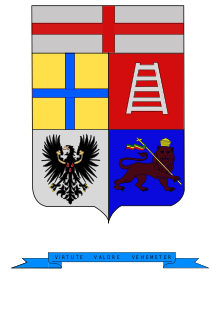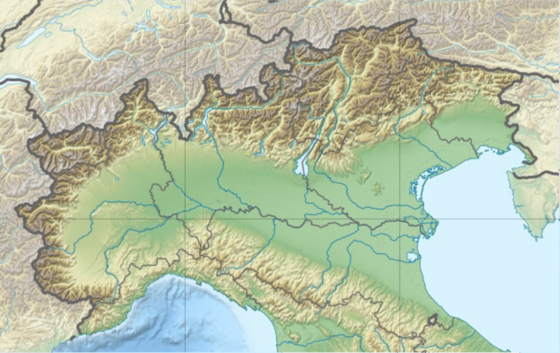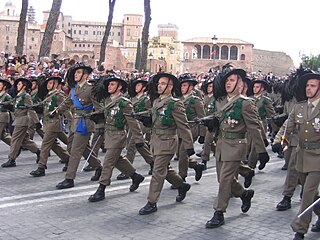
The Bersaglieri, singular Bersagliere, are a troop of marksmen in the Italian Army's infantry corps. They were originally created by General Alessandro Ferrero La Marmora on 18 June 1836 to serve in the Royal Sardinian Army, which later became the Royal Italian Army. They can be recognized by their distinctive wide-brimmed hats decorated with black western capercaillie feathers, which is worn with the dress uniform. The feathers are also applied to their combat helmets.
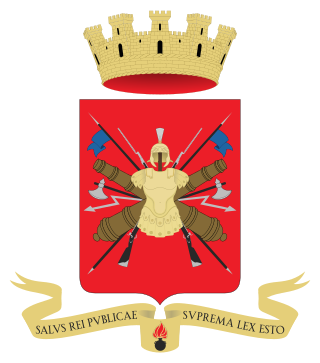
The Italian Army is the land force branch of the Italian Armed Forces. The army's history dates back to the Italian unification in the 1850s and 1860s. The army fought in colonial engagements in China, Libya, Northern Italy against the Austro-Hungarian Empire during World War I, Abyssinia before World War II and in World War II in Albania, Balkans, North Africa, the Soviet Union, and Italy itself. During the Cold War, the army prepared itself to defend against a Warsaw Pact invasion from the east. Since the end of the Cold War, the army has seen extensive peacekeeping service and combat in Afghanistan and Iraq. Its best-known combat vehicles are the Dardo infantry fighting vehicle, the Centauro tank destroyer and the Ariete tank and among its aircraft the Mangusta attack helicopter, recently deployed in UN missions. The headquarters of the Army General Staff are located in Rome opposite the Quirinal Palace, where the president of Italy resides. The army is an all-volunteer force of active-duty personnel.

The Comando Truppe Alpine or COMTA commands the Mountain Troops of the Italian Army, called Alpini and various support and training units. It is the successor to the 4º Corpo d'Armata Alpino of the Cold War. The Alpini are light Infantry units specializing in Mountain Combat. The subordinate units of the COMTA distinguished themselves during combat in World War I and World War II.
The article provides an overview of the entire chain of command and organization of the Italian Army after the reform of 1 May 2024 and includes all active units as of 1 May 2024. The Armed Forces of Italy are under the command of the Italian Supreme Defense Council, presided over by the President of the Italian Republic. The Italian Army is commanded by the Chief of the Army General Staff or "Capo di Stato Maggiore dell’Esercito" in Rome.
On March 1, 1984 the Italian Institute for Disarmament, Development and Peace (Istituto di ricerche per il disarmo, lo sviluppo e la pace in Rome published the entire Italian Army order of battle down to company level – this was justified by the radical party as one of its core demands was total disarmament of Europe, even though the data which was published was top secret. The Radical Party dissolved in 1989 and the IRDISP followed suit in 1990. But Radio Radicale has survived, and the OrBat can still be found today on the homepage of the radio.
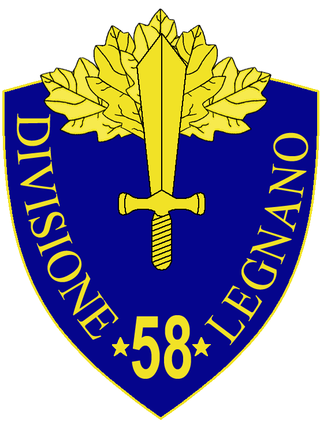
The 58th Infantry Division "Legnano" was an infantry division of the Royal Italian Army during World War II. The Legnano's predecessor division was formed on 8 February 1934 in Milan and named for the medieval Battle of Legnano. On 24 May 1939 the division split to form the 6th Infantry Division "Cuneo" and the 58th Infantry Division "Legnano". After the announcement of the Armistice of Cassibile the Legnano resisted the invading German forces. The division's staff and 67th Infantry Regiment "Legnano" were used to form the first unit of the Italian Co-belligerent Army, which fought on the allied side in the Italian campaign. On 17 February 1944 the division's last units joined other commands and the division was officially dissolved.

After World War II the Italian Army had two units named "Centauro": from 1952 to 1986 the Armored Division "Centauro" and from 1986 to 2002 the Armored Brigade "Centauro". Both units were successor to the World War II era 131st Armored Division "Centauro". The units' name came from the mythological race of half human-half horse creatures named Centaurs.

The Mechanized Brigade "Goito" was a mechanized brigade of the Italian Army. Its core units were mechanized Bersaglieri battalions. The brigade's headquarters was in the city of Milan. The brigade's name was chosen in memory of the First Italian War of Independence Battle of Goito, where the Bersaglieri corps had its baptism of fire.

The Mechanized Brigade "Brescia" was a mechanized brigade of the Italian Army. Its core units were mechanized infantry battalions. The brigade was founded in, named after, and headquartered in the city of Brescia and accordingly the brigade's coat of arms was modeled after the city's coat of arms.

The V Army Corps was one of three corps the Italian Army fielded during the Cold War. Based in the regions of Veneto and Friuli-Venezia-Giulia the corps was the army's main combat force. The 5th Army Corps was arrayed close to the Yugoslavian border and tasked with meeting any Warsaw Pact forces that crossed the border. On the left flank of the corps the 4th Alpine Army Corps was tasked with blocking the Alpine passes and in the rear of the corps the 3rd Army Corps served as operational reserve. After the end of the Cold War the corps was reduced in size and on 1 October 1997 it became the 1st Defence Forces Command. In 2013 the COMFOD 1° was disbanded and its function and brigades taken over by the 20th Infantry Division Friuli in Florence.

The Mechanized Brigade "Legnano" was a mechanized brigade of the Italian Army. Its core units were mechanized infantry battalions. The brigade's headquarters was in the city of Bergamo in Lombardy. The name of the brigade commemorates the Lombard League victory in the Battle of Legnano in 1176 and its coat of arms depicts the Monument to the Warrior of Legnano in the centre of Legnano.

The Motorized Brigade "Cremona" was an infantry brigade of the Italian Army. The brigade's headquarters was in the city of Turin. The brigade carried on the name and traditions of the 44th Infantry Division "Cremona".
The following is a hierarchical outline for the Italian Army at the end of the Cold War. It is intended to convey the connections and relationships between units and formations.
With the 1975 reforms the Italian Army abolished the regimental level and replaced it with brigades made up of multiple arms. During the reform the army disbanded 48 regimental commands and reduced its force by 87 battalions. A further ten regimental commands were used to raise ten new brigade commands. Ten training centers, which for traditional reasons had carried the names of regiments, were also disbanded. The reduction in units also allowed to mechanize most of the remaining units in Northern Italy and Italy's defense strategy changed from a hold-at-all-costs territorial defense to one of mobile warfare.

The 3rd Bersaglieri Regiment is an active unit of the Italian Army based in Teulada in Sardinia. The regiment is part of the army's infantry corps' Bersaglieri speciality and operationally assigned to the Mechanized Brigade "Sassari". The regiment is the highest decorated unit of the Italian Army with three Gold Medals of Military Valor. The regiment was formed in 1861 by the Royal Italian Army with preexisting battalions. During World War I the regiment served on the Italian front.

The 4th Tank Battalion "M.O. Passalacqua" is an inactive tank battalion of the Italian Army, which was based in Solbiate Olona in Lombardy and last operationally assigned to the Mechanized Brigade "Legnano". The unit's lineage traces back to the World War II IV Tank Battalion M13/40, which was formed in October 1940 by the depot of the 32nd Tank Infantry Regiment and attached to the 131st Armored Division "Centauro" for the Greco-Italian War. In April 1942, the battalion was transferred to the 133rd Tank Infantry Regiment, with which it deployed to Libya for the Western Desert campaign. In November 1942, the regiment and battalion were destroyed during the Second Battle of El Alamein. In 1959 the battalion was reformed and assigned to the 31st Tank Regiment. In 1963, the battalion was transferred to the 3rd Bersaglieri Regiment. In 1975 the battalion was renamed 4th Tank Battalion "M.O. Passalacqua". In 1992, the battalion was disbanded and its personnel used to form the 67th Armored Infantry Regiment "Legnano".

The 67th Infantry Regiment "Legnano" is an inactive unit of the Italian Army last based in Solbiate Olona. Formed in 1862 and originally named for the city of Palermo the regiment is part of the Italian Army's infantry arm. Since 1939 the regiment is named for the medieval Battle of Legnano.

The 68th Infantry Regiment "Legnano" is an inactive unit of the Italian Army last based in Bergamo. Formed in 1862 and originally named for the city of Palermo the regiment is part of the Italian Army's infantry arm. Since 1939 the regiment is named for the medieval Battle of Legnano.

The 11th Field Artillery Regiment is an inactive field artillery regiment of the Italian Army, which was based in Cremona in Lombardy. The regiment was formed in 1884 by the Royal Italian Army and served during World War I on the Italian front. In 1935 the regiment was assigned to the 3rd Infantry Division "Monferrato" and designated as 11th Artillery Regiment "Monferrato". In 1939 the division became the 3rd Infantry Division "Ravenna" and consequently the regiment was renamed 11th Artillery Regiment "Ravenna". In June 1942 the Ravenna division was ordered to deploy to the Eastern Front of World War II and before departing Italy the division exchanged artillery regiments with the 104th Infantry Division "Mantova".
